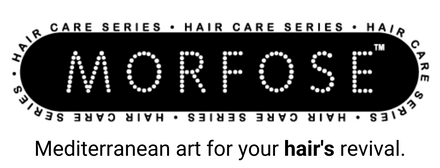Does Toner Damage Your Hair An Expert Guide
Posted by JENNIFER C.
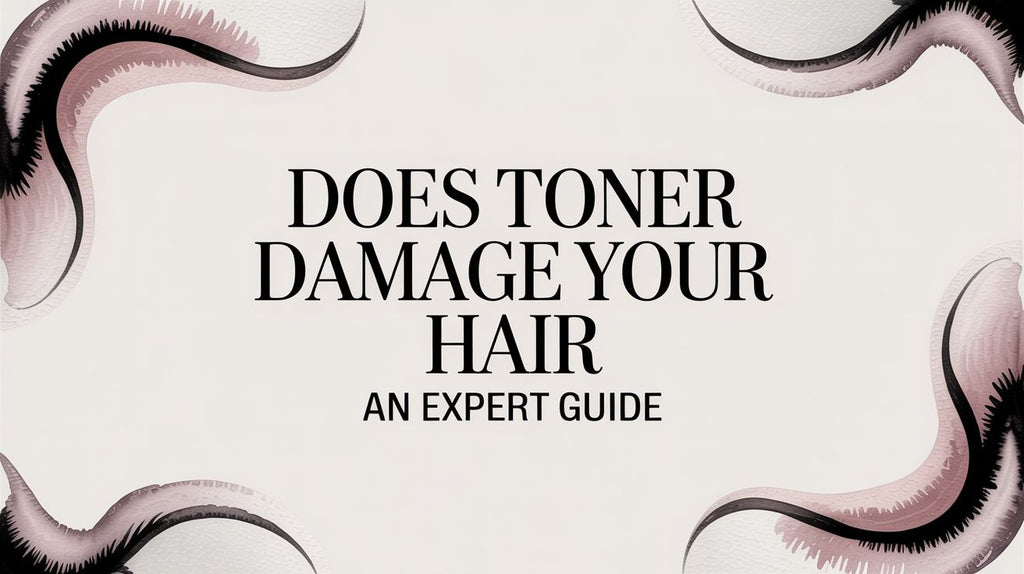
So, does toner damage your hair? Let's get straight to the point: toner itself isn't the bad guy. The real problem almost always comes down to two things: the condition of your hair before the toner even touches it, and how that toner is applied.
Think of it like this: you wouldn't put a fresh coat of paint on a crumbling wall and expect it to look perfect, right? The paint isn't the problem; the foundation is. It's the same idea with your hair.
Your Guide to Understanding Toner and Hair Health
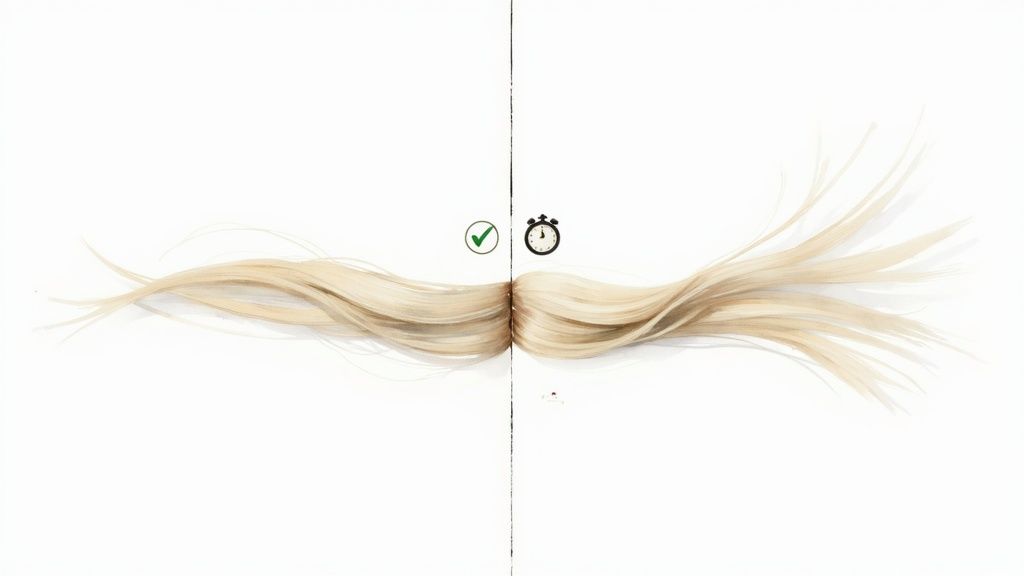
The words "chemical process" can sound scary, making it easy to lump toner in with more intense treatments like bleach. But toner's job is actually much more delicate. It's a finishing touch, designed to work on the surface of the hair shaft to correct and perfect the color.
Its primary role is to neutralize unwanted undertones. For blondes, that means kicking out those brassy, yellow hues to reveal a cleaner, cooler, or more ash-toned finish. The potential for damage sneaks in when other factors—often from services done right before toning—are already in play.
When a simple toning session goes wrong, it’s almost never the toner's fault alone. The most common culprits are applying it to hair that’s already been pushed to its limit by bleach, or making a mistake during the application itself. Slapping toner on fragile, over-processed hair is asking for trouble. Using too strong of a developer or leaving it on for too long can be the final straw for already stressed-out strands.
The Real Damage Factors
If toner is just the finishing touch, what are the real troublemakers? Here’s what actually puts your hair at risk during a color service:
-
Pre-Existing Damage: Toning is a breeze for healthy, well-conditioned hair. But if your hair is already weak from bleaching, frequent heat styling, or previous color services, it’s far more likely to react poorly. It just doesn't have the strength to withstand another process.
-
Application Errors: Technique matters. A lot. Overlapping toner onto hair that's already been toned, or leaving it on longer than the instructions recommend, is a classic cause of over-processing. This is what leads to that dreaded dry, brittle, straw-like texture.
-
Wrong Formula Choice: Not all toners—or more specifically, developers—are created equal. Using a high-volume developer on hair that has already been lifted to a light blonde is unnecessary and damaging. It forces the hair cuticle open more than needed, which roughens the hair’s surface and weakens its internal structure.
When used correctly on hair that's in good shape, toner is incredibly safe. But as any seasoned stylist will tell you, it can absolutely amplify existing damage from bleaching or heat. That's why having a professional check your hair's integrity first is non-negotiable. For a deeper dive, check out this in-depth guide on SalonsDirect.com that explores how your hair's health directly impacts toning results.
Toner Damage Risk Factors At A Glance
To make it even clearer, let's break down the difference between a high-risk situation and a safe toning practice. This table gives you a quick snapshot of what to watch out for versus what to aim for.
| High Risk Factors | Safe Toning Practices |
|---|---|
| Applying toner to over-bleached, porous hair. | Starting with healthy, well-conditioned hair. |
| Using a high-volume developer (20-vol or more). | Using a low-volume developer (10-vol or less). |
| Leaving the toner on for too long. | Following the recommended processing time exactly. |
| Overlapping applications on previously toned hair. | Applying toner only to the new or targeted areas. |
| Toning too frequently without proper aftercare. | Spacing out sessions and using restorative treatments. |
Ultimately, keeping your hair safe is all about respecting its limits. A healthy foundation and a careful, knowledgeable application are the keys to getting that perfect tone without paying the price in damage.
How Hair Toner Actually Works Its Magic
Before we can really get into whether toner is damaging, we need to talk about what it’s actually doing to your hair. Most people lump it in with harsh dyes, but that's not quite right. It’s better to think of toner as a sophisticated color corrector—the final, perfecting step after a lightening service.
Here’s a good way to picture it: Imagine you’ve painted a wall a gorgeous cream color, but a hint of the old, pesky yellow paint is peeking through. You wouldn't repaint the whole thing. Instead, you'd apply a sheer wash of a purple-tinted primer to cancel out that yellow. That's exactly what toner does, just for your hair.
The Science of Color Correction
The whole process is built on a fundamental principle you probably learned in art class: the color wheel. Every color has an opposite, and when they're mixed, they neutralize each other. This is a lifesaver when it comes to hair color.
- Yellow Tones: When hair is lightened to blonde, it often has a pale yellow cast. To fix this, a stylist will use a violet-based toner. Why? Because purple sits directly opposite yellow on the color wheel.
- Orange Tones: Hair that pulls more brassy or orange needs a blue-based toner to cool it down.
- Red Tones: And for those stubborn red undertones in brown hair? A green-based toner is the secret to neutralizing them for a perfectly cool brown.
Toner works by depositing just a tiny amount of these opposing pigments onto the hair. It doesn't actually make your hair lighter or darker; it just cancels out the unwanted tones, leaving you with a much cleaner, more refined result.
A Gentle Nudge for a Big Impact
So, how does that color get where it needs to go? It all comes down to the hair cuticle, which is the protective, outermost layer of each strand.
Toner is mixed with a low-volume developer, creating a formula that gently and temporarily lifts those cuticle scales. This small opening is just big enough for the toner’s color molecules to slip inside and work their magic. This step is absolutely necessary for the color correction to happen, but it’s not the same thing as damage, especially when done right. How your hair reacts really depends on its condition and porosity to begin with. You can dive deeper into this process by exploring the myths and facts of toning for stylists.
Think of your hair cuticle like the shingles on a roof. Toner is like a gentle breeze that lifts them just a tiny bit, and then they settle right back down. Aggressive bleaching, on the other hand, is like a hurricane that can rip them right off.
When a professional applies toner to hair that's in decent shape, the process is incredibly low-impact. The cuticle lifts, the pigment goes in, and a good conditioning rinse helps smooth that cuticle right back down, locking in your beautiful new tone. Understanding this is key, because it shows why the health of your hair before you even think about toning is the single most important factor.
Pinpointing the Real Causes of Toning Damage
So, if toner is just meant to correct color, why does it get such a bad rap for causing damage? The honest answer is that toner rarely acts alone. It's usually the final step in a much bigger chemical process, and the real damage was likely done long before a drop of toner was ever mixed.
Let's get to the bottom of what’s really going on.
Think about it like this: toning already-damaged hair is like putting a fresh coat of paint on a crumbling wall. The paint isn't the problem; the weak foundation is. The exact same principle applies to your hair.
The Role of Pre-Existing Damage
The single biggest factor determining if toner will harm your hair is its condition before you even start. If you're toning hair that's just been bleached, you have to remember that it's already in an incredibly fragile state. The bleaching process has to swell the hair's cuticle wide open to strip out the natural pigment, which, by its very nature, weakens the hair’s internal structure.
When you apply any chemical service to that compromised foundation—even a gentle one like toning—it can be the straw that breaks the camel's back. For a deeper dive into how coloring impacts your hair's health, you can check out the dangers of hair color damage and what you need to know. Hair that’s already porous and weak from being lightened is simply far more likely to end up dry and brittle.
This graphic breaks down how toner gets into the hair shaft to do its job.
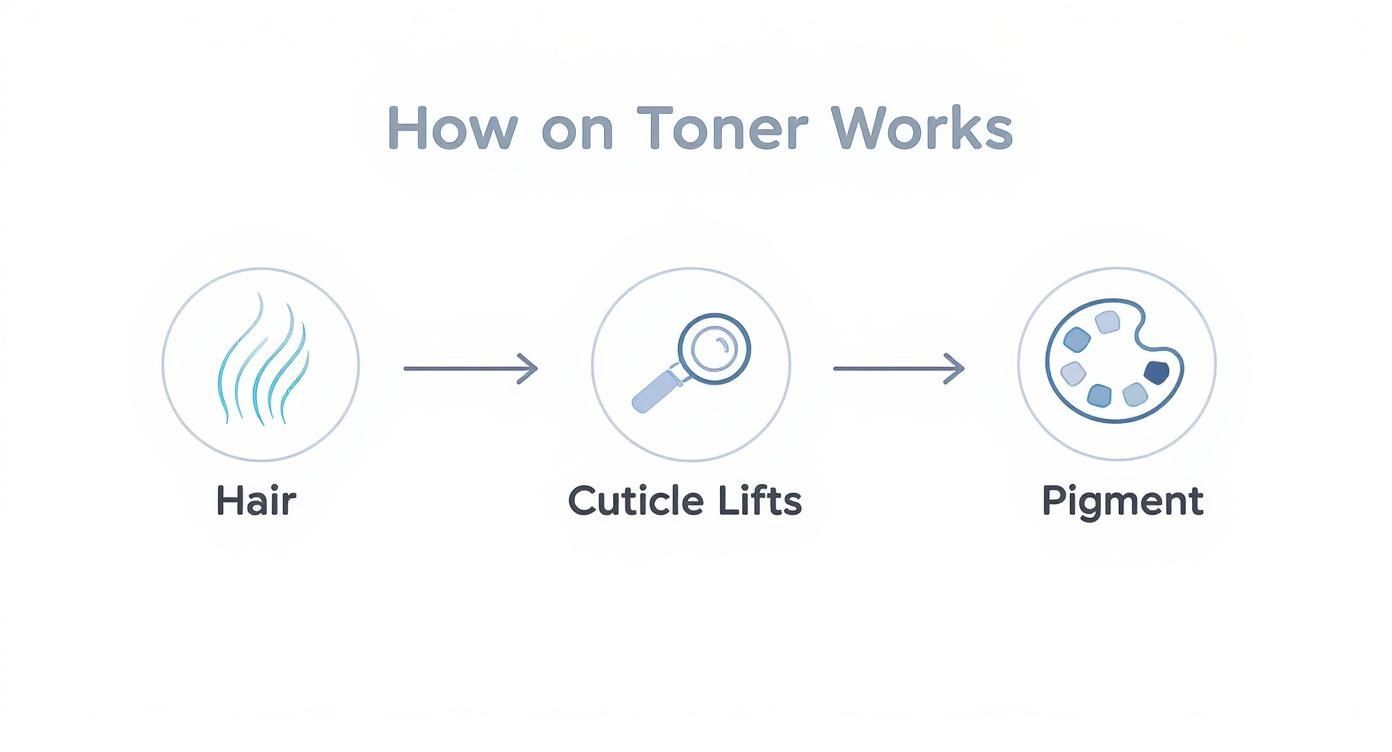
As you can see, the process relies on the cuticle lifting. That’s precisely why starting with strong, healthy hair is the best defense you have against damage.
Developer Strength and Hair Porosity
Not all toning services are the same, and the products used matter—a lot. The developer (peroxide) that gets mixed with the toner is a huge part of the equation.
- Low-Volume Developers (5-10 vol): Think of these as the gentle option. They have a very low concentration of hydrogen peroxide and are just strong enough to nudge the cuticle open for the color to get in. This is the standard choice for most professional toning.
- High-Volume Developers (20+ vol): These are much more aggressive and give you lift you don't actually need for toning. Using a high-volume developer on pre-lightened hair is a classic mistake that puts the hair under serious, unnecessary stress.
Your hair’s porosity is the other piece of this puzzle. Highly porous hair, which is a common side effect of bleaching, has a cuticle that's already wide open. It will soak up toner like a sponge, which not only risks a patchy, uneven result but also makes it incredibly vulnerable to over-processing and breakage.
The question we should be asking isn't "Does toner damage hair?" but rather, "What other factors are making my hair susceptible to damage during the toning process?" This small shift in perspective puts the focus back where it belongs: on overall hair health and proper technique.
Common Application Mistakes to Avoid
Finally, good old-fashioned human error can turn a perfectly safe process into a damaging one. These are the most common slip-ups that lead to toner-related trouble:
- Incorrect Timing: Leaving toner on for too long is probably the number one cause of over-processing. It can leave hair feeling brittle and can also deposit way too much pigment, giving you a muddy or overly gray, ashy tone.
- Overlapping Application: When you repeatedly apply fresh toner over parts of the hair that have already been toned, you create cumulative damage. Toner should only be applied precisely where it's needed, which is usually just the newly lightened hair or roots.
- Wrong Formula Choice: Using a toner that isn’t right for your hair's specific level of lightness or its undertones can give you a disappointing result. That often tempts people to tone it again right away, piling on more potential damage.
Recognizing the Warning Signs of Damaged Hair
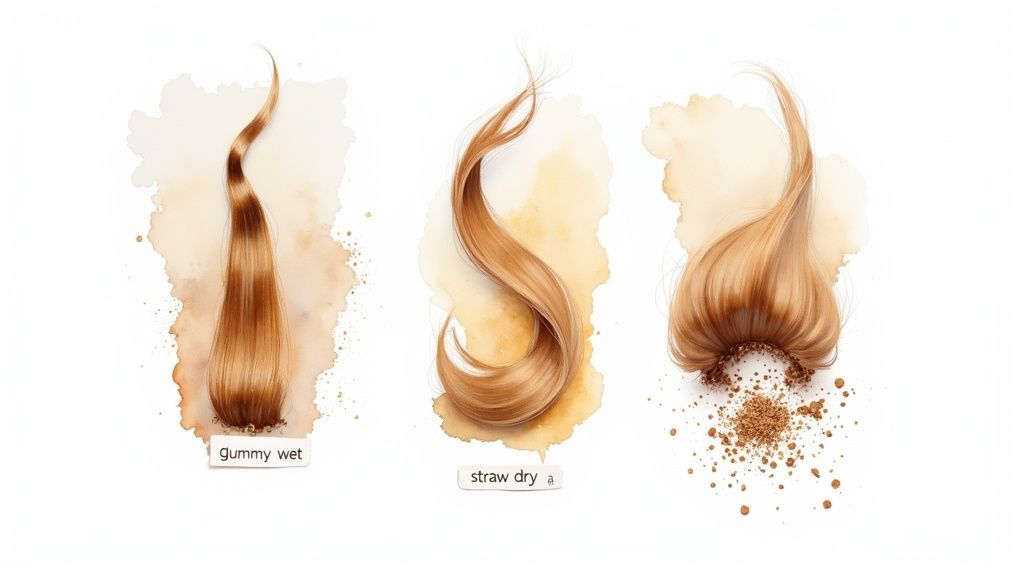
It’s so important to listen to your hair after any chemical service. Damage from over-processing doesn't always show up with a dramatic snap. More often, it starts as subtle shifts in how your hair feels and behaves.
Learning to spot these early warnings is the key to stepping in before a small issue spirals into a major problem. Healthy hair has a smooth, sealed cuticle that makes it feel strong and look shiny. When that protective layer gets roughed up—whether from aggressive bleaching or a toner left on too long—the first red flags start to wave. Honestly, your own hands are the best diagnostic tool you have.
Changes in Hair Texture
One of the first and most obvious signs of trouble is a weird change in texture. How your hair feels when it’s wet versus when it’s dry can tell you a whole lot about what’s happening on the inside.
-
Gummy or Mushy When Wet: Think about healthy wet hair; it should still feel relatively strong and sleek. If your hair instead feels mushy, overly soft, or stretches like a worn-out rubber band, that's a serious red flag. It means the core protein bonds have been severely weakened.
-
Straw-Like and Brittle When Dry: On the flip side, once the hair dries, it might feel incredibly rough, crunchy, and brittle. It gets tangled in a heartbeat and just doesn't have that soft, fluid movement anymore. It literally feels like straw.
This jarring difference happens because a damaged cuticle can't do its job of managing moisture. When wet, it soaks up way too much water and turns to mush. Then, as it dries, it can't hold onto any of that moisture, leaving it parched and brittle.
If your hair feels off after toning, pay attention. That’s your hair sending out an SOS. It's telling you its protective outer layer has been pushed too far and is struggling to hold everything together.
Breakage and Loss of Elasticity
Healthy hair is both strong and flexible—it has a natural give and bounce. Damage directly attacks these qualities, which is when you start seeing more breakage and less of that healthy spring.
There’s an easy way to check this yourself with a quick stretch test. Carefully take a single, damp strand of hair and gently pull on both ends. A healthy strand will stretch up to 30% of its length and then bounce right back. Damaged hair, however, will either snap almost immediately or stretch out and stay limp, not retracting at all.
This loss of elasticity is exactly why you start finding more hair in your brush, on your clothes, or noticing little broken bits around the sink. More split ends are another sign, as the weakened hair shaft starts to fray from the bottom up. Trust me, ignoring these signs is just asking for more trouble down the road.
Your Essential Aftercare Plan for Toned Hair
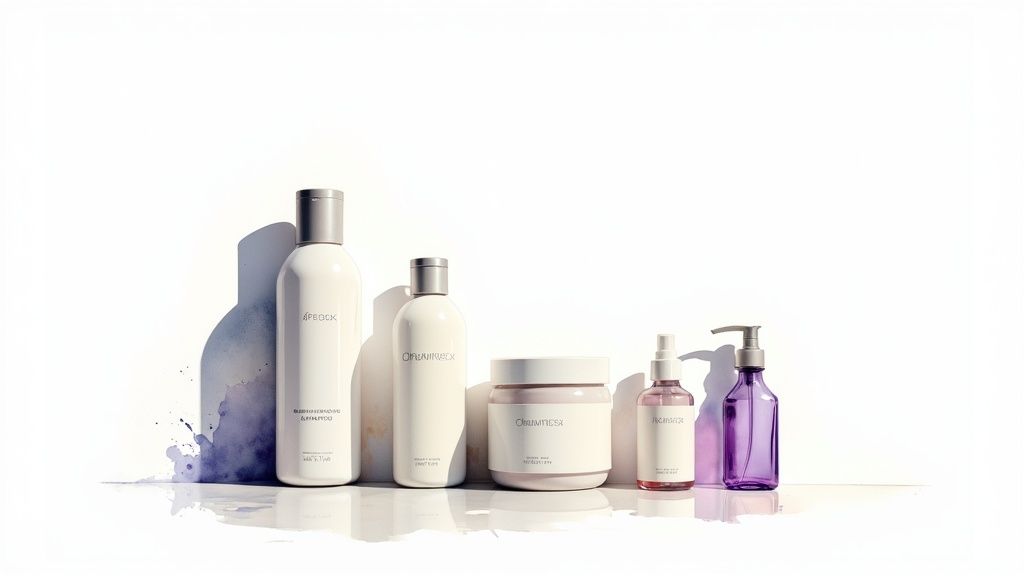
Perfecting your hair color doesn’t end the moment you rinse out the toner. In many ways, that’s when the real work begins. The next few weeks are absolutely critical for locking in that gorgeous new shade and nursing your hair back to health, especially if it was lightened beforehand.
Think of a smart aftercare plan as insurance for your hair. It’s your best defense against premature fading and damage, ensuring your investment of time and money pays off with vibrant, healthy hair that actually lasts. Without the right routine, even the most beautiful toning job can turn brassy and brittle in just a few washes.
Build a Color-Safe Foundation
First things first: you need to overhaul your shower routine. The products you use to wash your hair have the single biggest impact on how long your toner holds on. It’s time to retire any harsh, stripping shampoos and embrace formulas designed to protect your color.
Using a sulfate-free, color-safe shampoo is completely non-negotiable. Sulfates are powerful detergents that give you that rich, satisfying lather, but they’re also notorious for stripping color pigments and natural oils right out of your hair. This leads to faded color and chronic dryness. Making this one simple switch is probably the easiest and most effective thing you can do to extend the life of your toner.
While the toning process itself can be gentle, your follow-up care is what locks in the benefits. Modern toners are often formulated to be non-damaging and can even improve hair's condition by sealing the cuticle. Many contain moisturizing ingredients like squalane that boost shine and lock in moisture, but this good work can be undone without proper aftercare. As experts from Neal & Wolf explain, toners can strengthen hair while neutralizing brassiness, making your post-toning routine even more important.
Master the Moisture and Protein Balance
Chemically treated hair walks a tightrope between two essential needs: moisture and protein. After being toned, your hair has gone through a chemical shift that can leave it feeling thirsty and a bit fragile. Your job now is to give it back exactly what it’s craving.
-
Moisture: This is all about hydration. If your hair feels dry, rough, or brittle to the touch, it's begging for a deep conditioning or hydrating mask. These products replenish lost water, making hair feel soft and flexible again.
-
Protein: This is for rebuilding strength and structure. If your hair feels mushy, overly stretchy when it’s wet, or just limp and lifeless, it’s a cry for help. A protein treatment will patch up the gaps in the hair’s cuticle, reinforcing its internal structure from the inside.
Learning to "read" your hair is the key. A great place to start is by alternating between a moisturizing mask one week and a light protein treatment the next. This helps maintain that perfect equilibrium for healthy, resilient hair.
Smart Tools for Long-Term Maintenance
Beyond your core wash day routine, a few extra products in your arsenal will keep your color looking fresh and your hair feeling strong. These are your allies in the fight against fading and future damage.
Let's talk about purple shampoo. It’s an essential maintenance tool, but it's not a primary toning solution. Use it about once a week to knock out any new yellow tones that start to creep in, which keeps your blonde looking cool and bright between appointments. Overdo it, and you’ll end up with a dull, lilac-ish tint, so remember that less is more.
Next, incorporating bond-building treatments into your routine can be a total game-changer. These formulas work on a molecular level to repair the broken disulfide bonds inside the hair shaft—the very bonds that get damaged during chemical services. They literally rebuild your hair’s strength from within.
Finally, never, ever underestimate the power of a good heat protectant. Heat styling is one of the fastest ways to fade your color and cause damage. A quality heat protectant spray creates a crucial barrier between your hair and your hot tools, minimizing moisture loss and protecting the tone you worked so hard to achieve. For a deeper dive into post-coloring care, you can explore our complete guide on how to care for your hair after coloring.
Professional Toning Versus a DIY Home Kit
https://www.youtube.com/embed/B_u_NjVLre4
So, your hair is lightened, but it's not quite right. It's got that brassy yellow or orange tint you were hoping to avoid. Now you're facing a classic dilemma: book another appointment with your stylist, or grab a toning kit from the store and handle it yourself?
The temptation to save a little time and money with a DIY kit is real. But honestly, the question of "will toner damage my hair?" often hinges on who's mixing the formula and putting it on your head.
The Salon Advantage
When you're in a stylist's chair, you're getting more than just a product application. You're getting an expert analysis. A trained professional can see things you can't—they'll assess your hair's porosity (how well it absorbs and holds moisture), its elasticity, and any pre-existing weak spots. A box kit from the shelf just can't offer that kind of personalized diagnosis.
A stylist won't just grab a standard bottle. They'll custom-mix a toner formula specifically for you, selecting the gentlest developer possible to get the job done without stressing your hair. They apply it with precision, making sure not to overlap onto previously colored hair, which is a major cause of breakage.
This professional touch is all about minimizing risk and getting that flawless, even tone you're after. If your hair is already feeling a bit fragile, it's worth understanding the benefits of professional hair treatments for damaged hair to see why that expert care is such a smart investment.
The Risks of DIY Toning
When you tone your hair at home, you're suddenly the chemist and the artist. It's incredibly easy to get it wrong.
Key Takeaway: The line between a gorgeous cool blonde and dry, over-processed straw can be as simple as choosing the wrong developer or leaving the toner on for just a couple of minutes too long.
The most common mistakes we see from at-home toning attempts include:
- Choosing the Wrong Formula: Grabbing a toner that doesn't actually cancel out the specific brassy tones in your hair.
- Using Too Much Power: Using a developer that's way too strong for hair that's already been through a lightening process.
- Uneven Application: This is a big one. It's tough to apply color evenly on your own head, often resulting in a patchy, splotchy finish that needs a professional to fix.
Salon Toning Vs DIY Home Toning A Comparison
Deciding between a professional service and a home kit involves weighing expertise against convenience. This table breaks down what you can expect from each path.
| Factor | Professional Salon Toning | DIY Home Toning Kit |
|---|---|---|
| Expertise | Applied by a trained stylist who analyzes hair type, porosity, and damage. | Relies entirely on your own judgment and ability to follow instructions. |
| Customization | Formula is custom-mixed to target your specific undertones. | One-size-fits-all formula that may not suit your unique hair needs. |
| Developer Strength | Stylist chooses the lowest effective developer to minimize damage. | Kits often include a standard, potentially too-strong developer. |
| Application | Precise application prevents overlap and ensures even, seamless results. | High risk of uneven application, leading to splotchy color and breakage. |
| Cost | Higher initial cost for the service. | Lower upfront cost. |
| Risk of Damage | Very low. The primary goal is to protect hair integrity. | High, due to potential for misjudgment and application errors. |
Ultimately, while DIY toning might seem like a bargain, a single mistake can lead to an expensive color correction appointment and set your hair health back months. For the sake of your hair's beauty and integrity, letting a professional handle it is almost always the smarter, safer bet.
Your Top Hair Toner Questions, Answered
Alright, let's wrap this up by hitting some of the most frequent questions I get about toner. Think of this as your quick-reference guide to clear up any final bits of confusion and make sure you're toning your hair like a pro.
How Often Can I Safely Tone My Hair?
For most people with relatively healthy hair, toning every 4-6 weeks is a good rule of thumb. This isn't set in stone, though. If your hair is already feeling a bit stressed or damaged, you absolutely need to stretch that time out and focus on serious deep conditioning treatments in between.
A great trick to buy more time between full toning sessions is to use a color-depositing shampoo or conditioner. These are fantastic for a quick refresh without the commitment or potential stress of a chemical service.
Will a Toner Actually Lighten My Hair?
Nope, a standard toner won't lift or lighten your hair. Its one job is to deposit color to cancel out unwanted tones—think of it as color-correcting for your hair. It works on hair that has already been lightened to the right level.
If your hair looks brighter after toning, it’s not because it got lighter. It’s because the toner neutralized those brassy or muddy yellow tones, which creates a cleaner, more refined, and vibrant-looking blonde. It's a bit of an optical illusion.
What Happens If I Leave Toner on for Too Long?
Leaving toner on too long is one of the most common ways people accidentally damage their hair. When you over-process it, the hair can become dry, brittle, and overly porous. It's a recipe for breakage.
Beyond the damage, you can also end up with a color you didn't want. Too much time allows the toner to deposit way too much pigment, which can turn your beautiful blonde into a dull gray, a murky brown, or even a very obvious shade of purple or blue. Always, always stick to the recommended processing time.
For hair that needs some extra love and protection after toning, Morfose has your back. Check out our collection of color-safe shampoos, intensive masks, and reparative treatments designed to keep your color brilliant and your hair healthy at https://themorfose.com.

